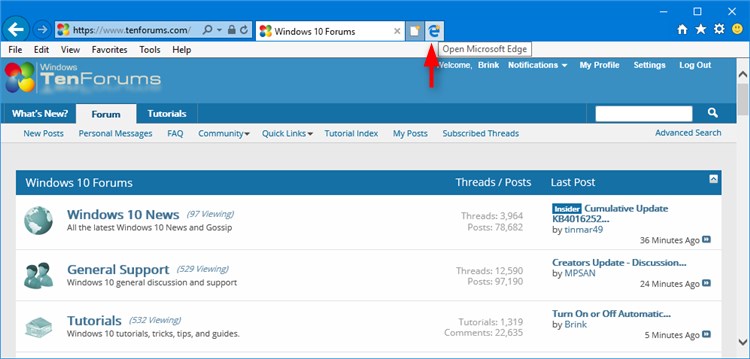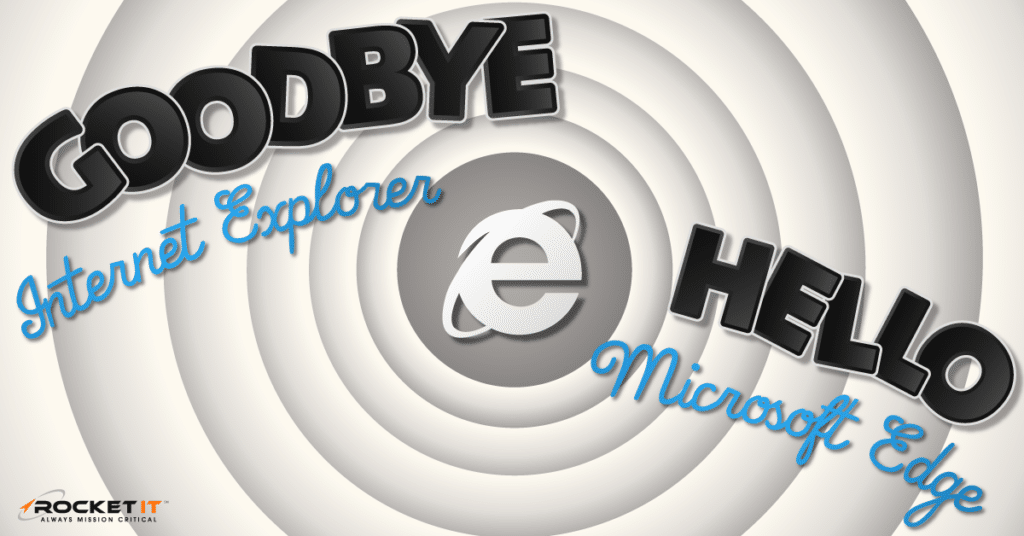Select a download
Internet Explorer Vs Microsoft Edge
Microsoft Edge is designed for faster, safer browsing and is recommended for Windows 10. But Internet Explorer 11 is also included in Windows 10 and is automatically kept up to date. To open Internet Explorer, select the Start button, type Internet Explorer, and then select the top search result.
- Microsoft Edge will ask to restart the browser, click on Restart button. After restarting Microsoft Edge, open any website and again click on 3-dots menu button present at the right-side of the toolbar. Now select “More Tools - Reload in Internet Explorer Mode” option and Microsoft Edge will start loading the website using IE engine.
- In Microsoft Edge. In the menu bar, select Settings and more, then select Settings. Select Appearance. Under Customize toolbar, for Show favorites bar, do one of the following.

Before installing, please note:
These virtual machines expire after 90 days. We recommend setting a snapshot when you first install the virtual machine which you can roll back to later. Mac users will need to use a tool that supports zip64, like The Unarchiver, to unzip the files.
The password to your VM is 'Passw0rd!'
View installation instructions
The Microsoft Software License Terms for the Microsoft Edge and IE VMs are included in the release notes and supersede any conflicting Windows license terms included in the VMs. By downloading and using this software, you agree to these license terms.
 -->
-->This article provides some information about the issue where an Internet Explorer or Edge window opens when your computer connects to a corporate network or a public network.
Original product version: Windows Server 2019, Windows Server 2016, Windows Server 2012 R2, Windows 10 - all editions
Original KB number: 4494446
Symptoms
You connect a computer that's running Windows 8 (or a later version) to a network in either of the following conditions:
- You connect your computer to a public network that requires Hotspot Sign in information (for example a hotel, airport, and so forth).
- You connect your computer to a corporate network that uses a proxy server to connect to the internet.
You notice the following behavior:
- The default browser (for example, Internet Explorer or Edge) opens, and shows a web page such as a sign-in page for the network or the MSN portal page.
- The network icon on the Task Bar shows an alert symbol (for example,). If you hover over the icon, you see a message such as 'No connectivity' or 'Limited Internet access.'
After you sign in to the network, you can use the network in the usual manner. After you use the network for a few seconds, the network alert on the Task Bar disappears.
Cause
This behavior is by design.
More information
Windows uses the Network Location Awareness (NLA) service to detect the properties of a network and determine how to manage connections to that network. NLA uses a component that is named the Network Connectivity Status Indicator (NCSI) to determine whether the computer has successfully connected to the network, and whether the network has intranet or internet connectivity.
NCSI uses both active and passive probes. These probes are triggered by changes in any of the network interfaces. When you connect your computer to a network as described in the Symptoms section, NCSI begins a process that includes one or more of the following:
NCSI active probes and the network status alert
The active probe process consists of the following steps:
Windows 10 or later versions:
NCSI sends a DNS request to resolve the address of the
www.msftconnecttest.comFQDN.If NCSI receives a valid response from a DNS server, NCSI sends a plain HTTP GET request to
http://www.msftconnecttest.com/connecttest.txt.If NCSI successfully downloads the text file, it makes sure that the file contains Microsoft Connect Test.
NCSI sends another DNS request to resolve the address of the
dns.msftncsi.comFQDN.- If any of these requests fails, the network alert appears in the Task Bar (as described in Symptoms). If you hover over the icon, you see a message such as 'No connectivity' or 'Limited Internet access' (depending on which requests failed).
- If all of these requests succeed, the Task Bar shows the usual network icon. If you hover over the icon, you see a message such as 'Internet access.'
Windows 8.1 or earlier versions:
NCSI sends a DNS request to resolve the address of the
www.msftncsi.comFQDN.If NCSI receives a valid response from a DNS server, NCSI sends a plain HTTP GET request to
http://www.msftncsi.com/ncsi.txt.If NCSI successfully downloads the text file, it makes sure that the file contains Microsoft NCSI.
NCSI sends another DNS request to resolve the address of the
dns.msftncsi.comFQDN.- If any of these requests fails, the network alert appears in the Task Bar (as described in Symptoms). If you hover over the icon, you see a message such as 'No connectivity' or 'Limited Internet access' (depending on which requests failed).
- If all of these requests succeed, the Task Bar shows the usual network icon. If you hover over the icon, you see a message such as 'Internet access.'
NCSI and the NLA service combine these responses with other information to build a profile of the network connection, or identify its existing profile. The network connection profile provides the information that Windows needs to configure the appropriate Windows Firewall profile:
- For Active Directory-authenticated networks: Firewall domain profile.
- For networks that the user has marked as 'private': Firewall private profile.
- For networks that the user has marked as 'public': Public firewall profile.
Note
You can use Group Policy to restrict the active probe process, and you can substitute a different website as a target (although this substitution is not a recommended solution). For more information, see the following resources:
Authentication and the automatic sign-in page

If the network requires credentials, Windows opens the default browser (such as Internet Explorer or Edge). If the network has a sign-in page, that page appears in the browser.
This behavior was introduced to improve the Windows user experience. In earlier versions of Windows, when you connect to a network that requires you to authenticate, the browser window does not open automatically. You may see a message that states that you must take further action in order to connect fully to the network. To complete the connection, you must click the message to open a browser window (or manually open a browser window) and enter a user name and password.
Because the network does not allow internet access without credentials, the network alert appears in the Task Bar.
NCSI passive monitoring, the MSN Portal page, and the network status alert
In addition to the active probes that this article describes, NCSI monitors the network activity of other applications on the computer. This passive monitoring process continues even if the active probe process fails. NCSI adjusts its network status determination based on whether other applications can make successful TCP connections. If a network alert appears because of a failed active probe, it disappears when a passive probe succeeds.
Note
The NCSI passive monitoring process does not transfer any information to or from your computer, and does not read any of the information that other applications transfer.
A thumbs-up gesture indicating approval. Thumbs Up was approved as part of Unicode 6.0 in 2010 under the name “Thumbs Up Sign” and added to Emoji 1.0 in 2015. Thumbs Up emoji is the picture of a centuries-old hand gesture, which looks like a fist with the thumb pointing up; and it is opposite to 👎 Thumbs Down emoji both by look and by meaning. It is the well-known symbol of approval and liking something — and the emoji, based on this gesture, is used online exactly in the same meaning. Thumbs Up has proudly been bringing innovation, fun, quality and value to the gifting market since its inception in 2004. As an award-winning, international design and distribution company – Thumbs Up produces quirky gadgets, gifts and homeware for retailers. Thumbs up copy. Emoji Meaning The Thumbs Up: Medium-Dark Skin Tone emoji is a modifier sequence combining 👍 Thumbs Up and 🏾 Medium-Dark 🖐️ Hand with Fingers Splayed Emoji Meaning A raised hand with a part between each finger and the thumb.
In some cases, such as when you connect to a network that uses a proxy server to connect to the internet or when network restrictions prevent NCSI from completing its active probe process, Windows opens the MSN Portal page in the default browser. If you analyze a network trace on the computer, it shows an HTTP connection to http://www.msftconnecttest.com/redirect that is followed by a connection to the MSN Portal. Windows opens this page for the benefit of the passive probe process. If the page loads, NCSI concludes that the computer has internet access. As the different probes fail and then succeed, the network status alert appears and then disappears.
Note
To prevent the browser window from opening when the computer connects to a network that has a proxy server, you have to configure the network firewall to allow access to the following URLs on port 80:
- *.msftncsi.com
- *.msftconnecttest.com
For more information, see KB 2778122, Using authenticated proxy servers together with Windows 8
Workaround
You can disable the NCSI active or passive probes by using the registry or Group Policy Objects (GPOs).

Caution
Internet Explorer Microsoft Edge Google Chrome
Microsoft does not recommend disabling the NCSI probes. Several operating system components and applications rely on NCSI. For example, if NCSI does not function correctly, Microsoft Outlook may not be able to connect to a mail server, or Windows may not be able to download updates even if the computer is connected to the internet.
To use the registry to disable NCSI active probes, configure one of the following registry keys.
Follow the steps in this section carefully. Serious problems might occur if you modify the registry incorrectly. Before you modify it, back up the registry for restoration in case problems occur.
HKEY_LOCAL_MACHINESYSTEMCurrentControlSetServicesNlaSvcParametersInternetEnableActiveProbing- Key Type: DWORD
- Value: Decimal 0 (False)
HKLMSoftwarePoliciesMicrosoftWindowsNetworkConnectivityStatusIndicatorNoActiveProbe- Key Type: DWORD
- Value: Decimal 1 (True)
Note
In the default registry configuration, this registry entry does not exist. You must create it.
To use the registry to disable NCSI passive probes, create the following registry key.
HKLMSoftwarePoliciesMicrosoftWindowsNetworkConnectivityStatusIndicatorDisablePassivePolling- Key Type: DWORD
- Value: Decimal 1 (True)
Note
In the default registry configuration, this registry entry does not exist. You must create it.
To use Group Policy to disable NCSI active probes, configure the following GPO:
- Computer ConfigurationAdministrative TemplatesSystemInternet Communication ManagementInternet Communication settingsTurn off Windows Network Connectivity Status Indicator active tests
- Value: Enabled
Install Microsoft Edge Browser
To use Group Policy to disable NCSI passive probes, configure the following GPO:
Internet Explorer Microsoft Edge
- Computer ConfigurationAdministrative TemplatesNetworkNetwork Connectivity Status IndicatorSpecify passive polling.
- Value: Enabled
